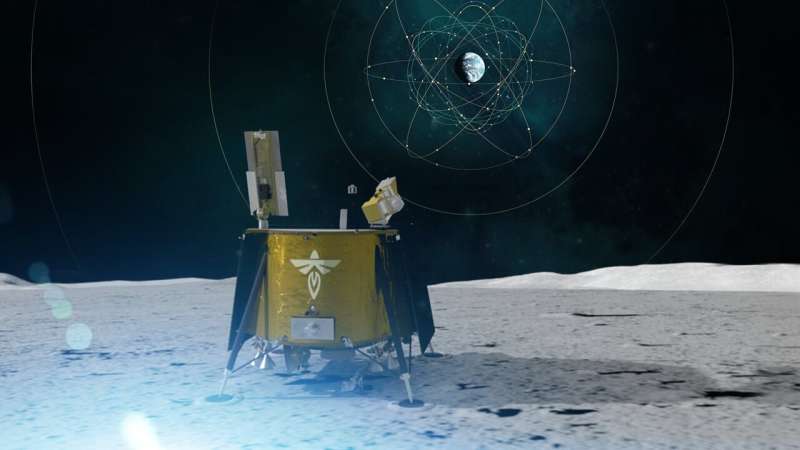
Copernical Team
Algorithm simulates intergalactic medium of the Universe in seconds
 The Instituto de Astrofisica de Canarias (IAC) has led the development of a new numerical procedure that allows to reproduce in a few seconds with Big Data and machine learning techniques the intergalactic medium obtained from a cosmological simulation of 100,000 hours of computation. Thanks to this algorithm, called Hydro-BAM, researchers have been able to exploit the hierarchy in the relations
The Instituto de Astrofisica de Canarias (IAC) has led the development of a new numerical procedure that allows to reproduce in a few seconds with Big Data and machine learning techniques the intergalactic medium obtained from a cosmological simulation of 100,000 hours of computation. Thanks to this algorithm, called Hydro-BAM, researchers have been able to exploit the hierarchy in the relations NASA's DAVINCI Mission To Take the Plunge Through Massive Atmosphere of Venus
 In a recently published paper, NASA scientists and engineers give new details about the agency's Deep Atmosphere Venus Investigation of Noble gases, Chemistry, and Imaging (DAVINCI) mission, which will descend through the layered Venus atmosphere to the surface of the planet in mid-2031. DAVINCI is the first mission to study Venus using both spacecraft flybys and a descent probe.
DAVINCI,
In a recently published paper, NASA scientists and engineers give new details about the agency's Deep Atmosphere Venus Investigation of Noble gases, Chemistry, and Imaging (DAVINCI) mission, which will descend through the layered Venus atmosphere to the surface of the planet in mid-2031. DAVINCI is the first mission to study Venus using both spacecraft flybys and a descent probe.
DAVINCI, Student-Built, Dime-Sized Instrument Is Venus-bound on NASA's DAVINCI
 Greenbelt MD (SPX) Jun 03, 2022
Venus Oxygen Fugacity (VfOx) is a small, button-sized sensor aboard NASA's DAVINCI mission to Venus' atmosphere that will be designed, fabricated, tested, operated, and analyzed by undergraduate and graduate students as the mission's Student Collaboration Experiment.
Planned for launch in 2029, the DAVINCI mission (Deep Atmosphere Venus Investigation of Nob
Greenbelt MD (SPX) Jun 03, 2022
Venus Oxygen Fugacity (VfOx) is a small, button-sized sensor aboard NASA's DAVINCI mission to Venus' atmosphere that will be designed, fabricated, tested, operated, and analyzed by undergraduate and graduate students as the mission's Student Collaboration Experiment.
Planned for launch in 2029, the DAVINCI mission (Deep Atmosphere Venus Investigation of Nob NASA selects new instruments for priority Artemis science on Moon
 Adding to the growing list of commercial deliveries slated to explore more of the Moon than ever before under Artemis, NASA has selected two new science instrument suites, including one that will study the mysterious Gruithuisen Domes for the first time.
These payload suites mark the second selection through the agency's Payloads and Research Investigations on the Surface of the Moon (PRIS
Adding to the growing list of commercial deliveries slated to explore more of the Moon than ever before under Artemis, NASA has selected two new science instrument suites, including one that will study the mysterious Gruithuisen Domes for the first time.
These payload suites mark the second selection through the agency's Payloads and Research Investigations on the Surface of the Moon (PRIS Perseverance Has a Pet Rock!
 How do you choose a rock on Mars? Sometimes you don't- it chooses you. For the past 4 months, Perseverance has had an unexpected traveling companion. Back on sol 341- that's over 100 sols ago, in early February- a rock found its way into the rover's front left wheel, and since hitching a ride, it's been transported more than 5.3 miles (8.5 km). This rock isn't doing any damage to the wheel, but
How do you choose a rock on Mars? Sometimes you don't- it chooses you. For the past 4 months, Perseverance has had an unexpected traveling companion. Back on sol 341- that's over 100 sols ago, in early February- a rock found its way into the rover's front left wheel, and since hitching a ride, it's been transported more than 5.3 miles (8.5 km). This rock isn't doing any damage to the wheel, but What the Voyager probes can teach humanity about immortality and legacy
 Voyager 1 is the farthest human-made object from Earth. After sweeping by Jupiter, Saturn, Uranus and Neptune, it is now almost 15 billion miles (24 billion kilometers) from Earth in interstellar space. Both Voyager 1 and its twin, Voyager 2, carry little pieces of humanity in the form of their Golden Records. These messages in a bottle include spoken greetings in 55 languages, sounds and images
Voyager 1 is the farthest human-made object from Earth. After sweeping by Jupiter, Saturn, Uranus and Neptune, it is now almost 15 billion miles (24 billion kilometers) from Earth in interstellar space. Both Voyager 1 and its twin, Voyager 2, carry little pieces of humanity in the form of their Golden Records. These messages in a bottle include spoken greetings in 55 languages, sounds and images Earth from Space: Puglia, Italy

Part of Puglia, or Apulia, a region in southern Italy, is featured in this image captured by the Copernicus Sentinel-2 mission.
NASA moon mission set to break record in navigation signal test

As the Artemis missions journey to the moon and NASA plans for the long voyage to Mars, new navigation capabilities will be key to science, discovery, and human exploration.
Through NASA's Commercial Lunar Payload Services initiative, Firefly Aerospace of Cedar Park, Texas, will deliver an experimental payload to the moon's Mare Crisium basin. NASA's Lunar GNSS Receiver Experiment (LuGRE) payload will test a powerful new lunar navigation capability using Earth's Global Navigation Satellite System (GNSS) signals at the moon for the first time. GNSS refers to satellite constellations commonly used for position, navigation, and timing services on Earth.
Magnetic vortices explain mysterious auroral beads

One solar stormy day in November 2018, 13 spacecraft including ESA’s Cluster mission were in the right place at the right time to spot a process that has never been seen in its entirety before. Their observations explain how vortices at the edge of Earth’s magnetosphere can cause auroral beads to dot the sky a hundred thousand kilometres below.
Five things to know about NASA's new mineral dust detector
 Each year, strong winds carry more than a billion metric tons - or the weight of 10,000 aircraft carriers - of mineral dust from Earth's deserts and other dry regions through the atmosphere. While scientists know that the dust affects the environment and climate, they don't have enough data to determine, in detail, what those effects are or may be in the future - at least not yet.
Launchin
Each year, strong winds carry more than a billion metric tons - or the weight of 10,000 aircraft carriers - of mineral dust from Earth's deserts and other dry regions through the atmosphere. While scientists know that the dust affects the environment and climate, they don't have enough data to determine, in detail, what those effects are or may be in the future - at least not yet.
Launchin 
